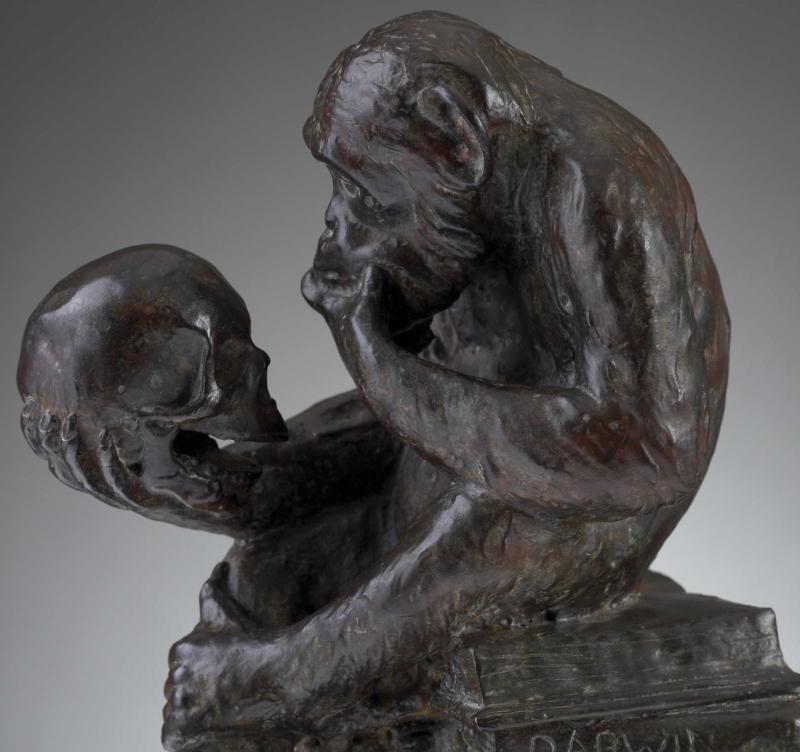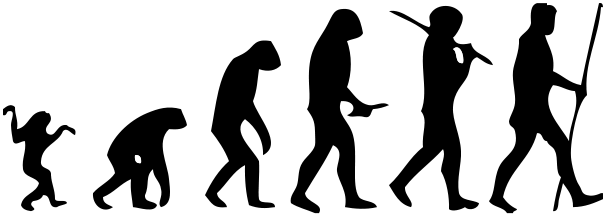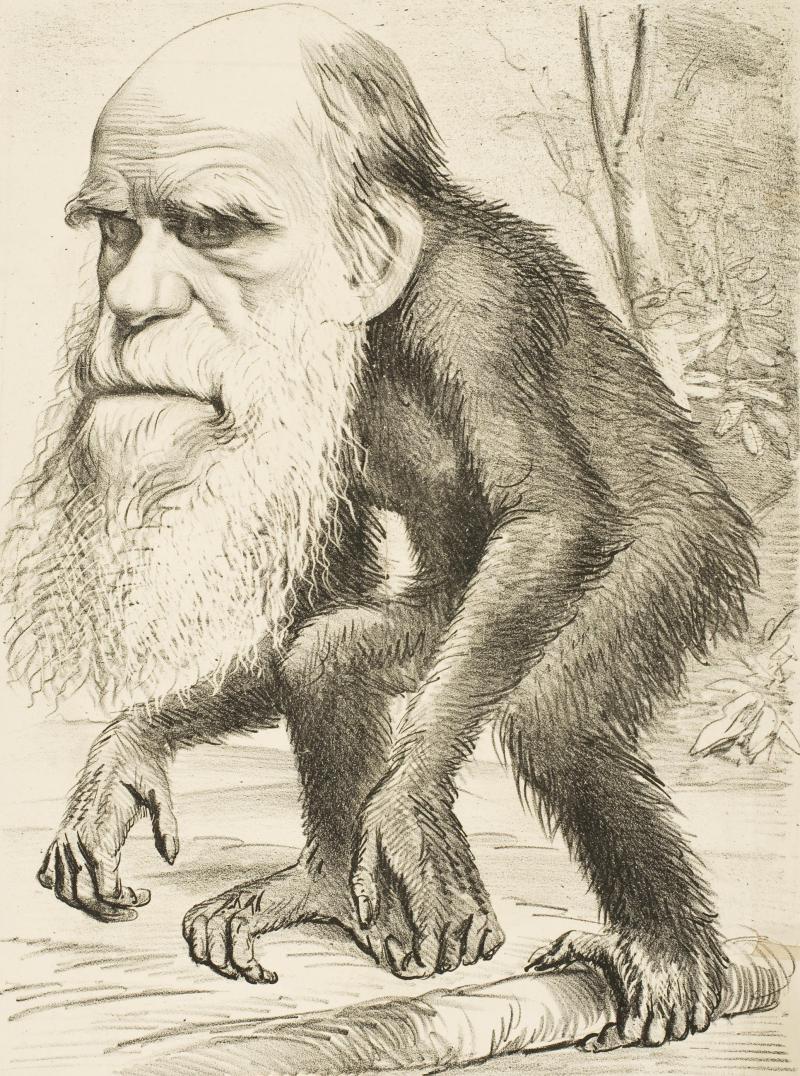I have a three-year-old daughter who is obsessed with Curious George. I think I can recite every word to every one of the 102 episodes, which means that I know roughly 102 scenarios in which the Man with the Yellow Hat tells George, “Be a good little monkey,” which in turn means my daughter is familiar with the 102 scenes in her favorite show that make her mother yell “APE!” Yes, Curious George is not a monkey; he is a chimpanzee, which makes him an ape, as the Man with the Yellow Hat should well know as a scientific illustrator of some kind and with a scientist (who, alas, wears a lab coat) for a best friend. But I am digressing a little bit because ape vs. monkey is not the subject of this post. The subject is:
Misconception: Humans evolved from monkeys.
Correction: Modern humans and modern apes share a recent common ancestor.
In biology, we name organisms according to their evolutionary history—who your most recent ancestors were determines what you are. Apes like Curious George (along with gorillas, Neanderthals, modern humans, and many other lineages) are called apes because they descended from a common ape ancestor, not a monkey ancestor. So if anything, humans most recently evolved from apes, not monkeys, but we didn’t really do that either, at least not in the way many people understand it. Often, when people say or hear “humans evolved from apes,” they picture apes as we know them (that is to say, modern apes) turning into humans. People in the anti-evolution camp mistakenly try to use this as an argument against evolution: You silly scientists, they say, patting us on the head, how can we have evolved from chimpanzees if there are still chimpanzees?
Right. How indeed? The reason is, of course, that we did not evolve from modern chimpanzees. Rather, humans and chimpanzees both evolved from a common, now extinct, ancestor. So, instead of “humans evolved from apes” one really should say “modern humans and modern apes evolved from a common ancestor.”
Fossil and genetic evidence suggest this ancestor, let’s call it “CHAP” (Chimp-Human-Ancestral-Populations), lived about 6 million years ago. As its name (if not its acronym) suggests, CHAP was not an individual, but rather a group of populations. One of these populations evolved—over many thousands upon thousands of generations—to become modern-day chimps (Pan troglodytes, the common chimp, and Pan paniscus, the bonobo). Another one of the populations evolved—again, over many thousands upon thousands of generations—to become a variety of hominins, including us (Homo sapiens).
I’m painting a very simple picture here. I have so far described only the initial split. Evolution-by-splitting, in which A becomes B and C, is called cladogenesis, and it occurred many times along both the modern human and chimp lineages after that initial split. Linear evolution, or anagenesis, in which A becomes A’, also happened along both evolutionary paths. With anagenesis, there is observable directional change within a group. When people are confused that there are still chimps today, they are usually under the impression that all evolution happens in this linear way, but actually, the consensus among evolutionary scientists is that cladogenesis has been, by far, the more important pattern in the history of life.

So what should you say if a child—or anyone!—confronts you with the idea that evolution can’t be true because they saw chimps just the other day at the zoo? I suggest you explain (with as little judgment as possible) that we did not evolve from modern chimps; rather, both modern chimps and modern humans evolved from a common ancestor. You can always bring in a very common analogy to help get this important idea across: the family tree. Siblings share a common ancestor—usually called “mom” and “dad”. (This is a good time to reiterate that despite the name, “common ancestor” does not mean one, single, individual ancestor, but a group of individuals that lived at the same time and contributed genetic material to their descendants). Chimps and humans are a lot like siblings. In fact, they are so much like siblings, that we call chimps our “sister taxa.” (A 2010 paper by NCSE alums Genie Scott and Eric Meikle for Evolution: Education and Outreach explains this analogy thoroughly and has some nice diagrams that illustrate the parallel relationships among family members to those of modern humans and apes.)
 Another paper, this one in The American Biology Teacher (Johnson and others, 2012), provides a few common questions and answers about human evolution. For example, they delve into exactly what fossil and genetic evidence tells us about CHAP, explaining that CHAP probably appeared to have more in common with modern chimps than modern humans, especially in terms of cranial features such as brain size, prominence of canine teeth, and a jaw that projected out from the face. This does not mean, however, that modern humans are somehow “more evolved” than modern chimps! Rather, data suggest that both lineages have undergone evolution at roughly equivalent amounts of evolutionary change since the time of the split, though certain types of evolutionary change have occurred more frequently in the human lineage, especially at the level of gene regulation and biological changes that involve the brain. (See the linked American Biology Teacher paper above for more detail on this.)
Another paper, this one in The American Biology Teacher (Johnson and others, 2012), provides a few common questions and answers about human evolution. For example, they delve into exactly what fossil and genetic evidence tells us about CHAP, explaining that CHAP probably appeared to have more in common with modern chimps than modern humans, especially in terms of cranial features such as brain size, prominence of canine teeth, and a jaw that projected out from the face. This does not mean, however, that modern humans are somehow “more evolved” than modern chimps! Rather, data suggest that both lineages have undergone evolution at roughly equivalent amounts of evolutionary change since the time of the split, though certain types of evolutionary change have occurred more frequently in the human lineage, especially at the level of gene regulation and biological changes that involve the brain. (See the linked American Biology Teacher paper above for more detail on this.)
I want to conclude with a plea for compassion when confronted with questions along the lines of “If we evolved from chimps, why are there still chimps?” This stuff can be hard to wrap our heads around. And certainly in the case of children, the ignorance is not usually willful. I can’t tell you how often I’ve listened to scientists bungle this topic, saying we evolved from chimps instead of the more appropriate “chimp-like ancestors.” And even if said correctly, it’s completely understandable that “chimp-like ancestors” gets translated to “chimps” in someone’s head. So have patience. Muster some good resources and lay it out with compassion and empathy. Hopefully, your students will be more teachable than the Man with the Yellow Hat is—no matter how many times I try to explain it to him, he still tells George to be a “good little monkey.”

